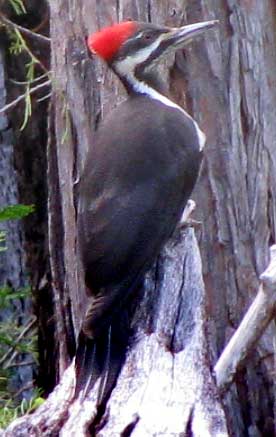Excerpts from Jim Conrad's
Naturalist Newsletter
from the May 4, 2003 Newsletter, issued from near Natchez, Mississippi:
PILEATED WOODPECKER ON A ROTTEN LOG
 I was sitting beside a forest pool scanning the opposite bank with my binoculars, mostly watching dragonfly-wing sun-glitter slitting the deep shadows across from me, and brown Mosquitofish hovering near the water's surface, their fins fanning calmly like the tails of contented grazing cattle. But then a crow-size Pileated Woodpecker rampaged right into my field of vision, not 20 feet from me, and plopped onto the trunk of a large tree that long ago fell from the bank into the water, and now lay there rotting.
I was sitting beside a forest pool scanning the opposite bank with my binoculars, mostly watching dragonfly-wing sun-glitter slitting the deep shadows across from me, and brown Mosquitofish hovering near the water's surface, their fins fanning calmly like the tails of contented grazing cattle. But then a crow-size Pileated Woodpecker rampaged right into my field of vision, not 20 feet from me, and plopped onto the trunk of a large tree that long ago fell from the bank into the water, and now lay there rotting.
It just happened that at that moment my elbows rested nicely on my knees, so didn't need to readjust my position to keep my arms from getting tired holding the binoculars. For half an hour I watched that woodpecker, never moving a hair, and he never knew that I was there.
In my sense-focused mode I tingled with pleasure when the big bird's bright red crest for a moment traversed a ray of brilliant sunlight. I watched him awkwardly hop backwards as he worked along the fallen trunk, and I laughed at the surprised look on his face when he disturbed a large centipede that ran toward him, causing him to jump upward and flutter his wings like a kid who almost steps on a gartersnake. I laughed again when a chipmunk emerged from under his log and he jumped and fluttered the same way again. I saw him go to the pond's edge, daintily douse his gangly body with water, then fly onto a nearby trunk and preen himself luxuriously.
He pecked and chiseled back and forth atop the fallen log and along its sides for a long time, finally settling on one spot where he began pecking with obvious concentration. Within five minutes he withdrew from his hole a white grub the size of which made me gasp, one as large as my whole thumb. He set the grub on the trunk and beat it with his bill until it stopped squirming. It was a succulent grub, so its body fluids splattered through rays of sunlight. Then the bird took up the grub, positioned it just right in his beak, and made several attempts before finally gulping it down. I hadn't been sure he could do that, for the grub was longer than his entire beak, and thicker, too.
The woodpecker then flew away, leaving in my field of vision dragonfly-wing sun-glitter and hovering Mosquitofish.
I went to see the hole from which the grub had been be extracted. It was a typical Pileated-Woodpecker hole, rectangular, about two inches long and an inch wide, and some two inches deep. A spot next to the hole was greasy, where the grub had been worked over prior to being swallowed. A dozen or so very small black ants fed in the greasy spot, and I marveled that they had found the spot so quickly, and that they so attentively gathered up whatever of the undone grub they could find, even if it was only pulpy wood soaked in the grub's nutrient-rich juices.
A beetle grub, a Pileated Woodpecker, a tribe of ants, and me, all feeding in our various ways on a rotting log next to a seldom visited forest pond...